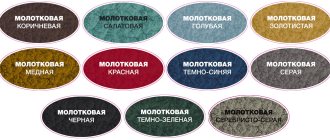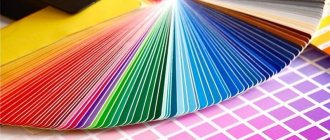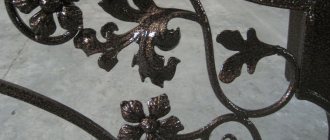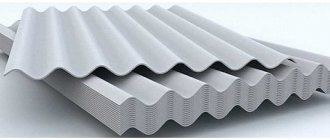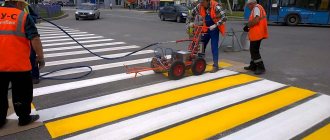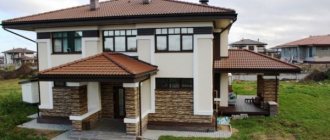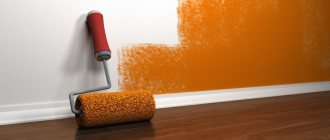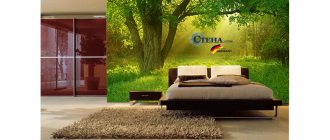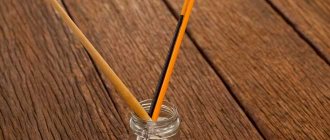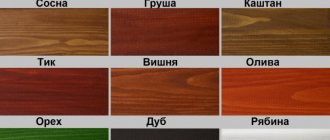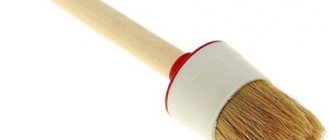Soundproofing paint can be used for painting various types of foundations of residential buildings and technical buildings.
Insulation is designed to prevent the penetration of moisture (especially increased amounts), electric current and various types of noise into the room.
Does not allow moisture to penetrate
Waterproofing is one of the most important issues that can be solved using dye. It should also be noted that almost all paintwork materials are to some extent endowed with waterproofing qualities. But, if you need really durable and high-quality protection, it is still recommended to use special-purpose paints.
Planes and structures coated with such mixtures even cope with direct exposure to water (and for a fairly long period of time).
All coloring agents that are classified as waterproofing have certain characteristics:
- The paint must be repurposed for both internal and external surfaces. This will significantly increase the degree of strength.
- In addition to being resistant to moisture, such paints must also withstand sudden changes in temperature and resist UV radiation.
- In addition to other fillers, mixtures must contain antiseptic and additives that protect surfaces from the negative effects of salts. Antiseptics are one of the most important components of such paints, because if the bases are wet, the formation of mold, fungi and rot is guaranteed.
In order for the paint to retain its qualities, it must be stored correctly. As a rule, all the necessary information can be found on the container with the material. But regardless of the information on it, you need to know that coloring agents cannot be kept at too low or, conversely, high temperatures. Well, of course, you always need to look at their expiration dates.
Soundproofing qualities
In order to ensure sound insulation there is no need to use various third-party materials. Special paint also copes with this task quite well.
All soundproofing dyes have distinctive features:
- They are made from bitumen or acrylic composite components. And those, in turn, also have some differences. Thus, acrylic compositions are recommended for indoor use due to their harmlessness and odorlessness, because they are water-based. Compositions containing bitumen, on the contrary, are more suitable for covering facades. They have a rather unpleasant odor that is difficult to remove. In addition, such paints are several times cheaper than acrylic ones. And this is undoubtedly an advantage when it comes to large quadratures.
- It is recommended to apply coloring agents in several approaches in thick layers. This provides a higher degree of noise insulation factors. You can use a brush or a paint roller. It is worth noting that the paint will dissolve upon contact with synthetic compounds.
- Bituminous waterproofing paints are also more suitable if it is necessary to paint movable elements (for example, car parts). Moreover, the paint absorbs vibrations well.
Areas of application
Insulating materials can be used to protect buildings of various types - not only residential, but also for technical purposes. Insulation can protect the room from excessive humidity, electric current and noise exposure.
Moisture protection
The issue of waterproofing is one of those problems that can be solved with the help of paint and varnish material. It should be noted that most paints, one way or another, have waterproofing properties. However, if you need truly serious protection, you cannot do without a special coating. After coating with this composition, the surface will withstand even direct exposure to water for a long time.
Waterproofing coatings must have certain qualities:
- The paint should be intended for both interior work and facade finishing, since double-sided painting provides more reliable protection.
- It is desirable that, in addition to moisture resistance, the paintwork material is resistant to ultraviolet rays and temperature changes.
- The composition should include anti-salt additives and antifungal drugs. Antiseptic qualities are very important for good waterproofing, because moistened material is an ideal place for the development of mold and mildew.
Note! The quality of the paint and varnish material is influenced not only by its shelf life, but also by storage conditions. The paint should not be placed in areas that are too cold (at sub-zero temperatures) or too hot. Information on storage times and conditions can be found on the product packaging.
Noise insulation
An increased level of sound insulation can be achieved by painting the surface with special paint. Soundproofing coatings have a number of characteristic features:
- The basis of this type of paint is bitumen or an acrylic composite element. Both substances have a number of features: acrylic is better suited for interior work, since it is practically odorless (water-based), and bitumen is much more effective outdoors, but is not suitable for indoors, as it smells unpleasant. At the same time, bitumen coatings are much cheaper than acrylic ones, which is important when painting large areas.
- The maximum level of sound insulation can be obtained if the composition is applied in a thick layer. It is recommended to use a brush or roller as a working tool. The paint dissolves in a synthetic composition.
- For insulating moving elements (for example, machine or car parts), bitumen-based paints and varnishes are best suited. This group of paints is capable of absorbing not only sounds, but also vibrations.
Soundproofing walls with insulation
Mineral wool, which is hidden under plaster, is also widely used to soundproof walls in apartments. Insulation is available in the form of mats and slabs. Mats are usually laid in those rooms that are lined with plasterboard, as a result of which this finish is often found in offices and factories and very rarely in residential premises.
Expert opinion
Sergei Shablovsky
Plasterer
For sound insulation located under the frame, the optimal density is 40-60 kg/m3.
It’s another matter when basalt slabs bear the load of decorative finishing. In order to withstand the weight of plaster, putty and not deform, the soundproofing layer of insulation must have a density of 100 kg/m3 and higher.
An example of brands of suitable basalt slabs: ROCKWOOL FLOOR BUTTS, TechnoNIKOL TECHNOFAS.
Installation of such a noise-absorbing finish under plaster is carried out as follows:
- First, the wall surface is prepared. The wallpaper is torn off, the old paint is removed. The existing cracks in the plaster are opened, after which they are sealed with ordinary gypsum or cement-sand mortar. As a result, you need to get a flat vertical plane.
- Next, using mounting adhesive, sound insulation is attached to the wall. For better fixation of the slabs, it is additionally attached to disc-shaped dowels - 5 pieces per slab.
Glue is applied to walls and main wool - On top of the insulation, another layer of glue is applied and leveled with a notched trowel, on which a plaster reinforcing mesh made of fiberglass is applied. The mesh is completely hidden in the solution. This method of plastering is exactly the same as when insulating facade walls (wet facade).
Installed soundproofing mats are plastered with reinforced glue - After a week, you can do the final finishing: putty for painting, decorative plaster, or wallpaper.
Advantages of the method : high sound absorption, ease of installation.
Disadvantages : sound insulation “eats up” the interior space of the room.
How to make sound insulation in an apartment under plaster is shown in the video lesson:
Electrical insulating compounds
To protect against current, special paints with electrical insulating properties are produced. The cost of such coatings is quite high, but the importance of electrical insulation is also great, since the safety of residents depends on it. The main qualities of electrical insulating paints (in addition to the main one - protection against current) are durability and resistance to other negative environmental influences (ultraviolet radiation, moisture, temperature changes, etc.).
There are different brands of electrical insulating compounds on the market, the most common of which are:
- EP-969 is intended for painting metal pipelines. The enamel is heat resistant and can withstand temperatures up to 150 degrees above zero.
- EP-919 is used for processing a variety of metal surfaces. A characteristic feature of EP-919 is its high anti-corrosion qualities.
- GF-92 and EP-9111 are most often used for painting windings on electrical equipment.
Note! Applying an electrical insulating coating is too important a task to do it yourself without experience. It is better to entrust such work to specialists.
Other types of insulating paints
Among other types of paint and varnish insulators, thermal insulation and heat-insulating compounds should be distinguished.
Thermal insulating coatings are able to withstand heating to high temperatures without losing their qualities. Such paints are used for painting very hot surfaces (fireplaces, stoves, etc.).
Thermal insulating coatings are used to reflect heat from the surface. Due to the formation of a special film, a shielding coating is created, so the room will not be as hot as it could be.
Other types of compounds
It is worth noting some other compositions:
- Thermal insulating paints can withstand heating to enormous temperatures without losing their performance properties. (See also the article Paint for fireplaces and stoves: features.)
This paint can be used to paint fireplaces, barbecues and other heating products.
- Thermal insulation compounds are still not widespread, but every year they become more and more popular. Once applied, they create a film that can reflect heat and serve as a kind of screen.
Soundproofing plaster
Sound insulation can be ensured not only through the use of paints and varnishes, but also through soundproofing plaster. The composition of the plaster includes special components, the presence of which ensures insulation from sound influences. We are talking about fillers in the form of small 5 mm granules. Expanded clay or pumice is most often used as a material for granules. Moreover, the granules are lightweight because they have a hollow structure.
Aluminum powder can also be added to the soundproofing composition. When such a powder goes through the drying stage, gas is released from it, which ensures the porosity of the material. The loose structure allows the propagation of sound to be delayed, since the waves are repelled by very small particles.
Note! There is a misconception about the inability of plaster to act as sound insulation. In fact, a plastered surface can absorb a significant part of the sound wave, but only if the composition was applied in compliance with the technology.
It is not recommended to paint a plastered wall with thick paints and varnishes such as enamel, since such actions lead to the loss of a significant part of the soundproofing properties. The fact is that thick compositions fill the small pores of the plaster, which negates all the advantages of the porous material. In addition, you should not cover the plaster with wallpaper, since the glue (viscous substance) also clogs the pores.
Plaster is an environmentally friendly material, so it can even be used in children's rooms. In addition, relief-plastered walls look very decorative, making them pleasing to the eye and can, in addition to their utilitarian function (protection from noise), play the role of interior decoration.
Acoustic panels for finishing
You can improve the sound insulation of walls and ceilings using special panels, for example SonoPlat, ZIPS-Vector Sandwich Panel, etc. This product is a thin, heavy board made of pressed wood-fiber sheet.
In the thickness of the panel there are corrugations filled with fine mineral filler
With a thin thickness of only 12 mm, the panels have an airborne sound insulation index of 38 dB, which makes them effective in this area.
Soundproofing panels are able to absorb noise over the entire frequency range. In addition, the use of this soundproofing method eliminates so-called sound bridges. The panels reduce the transmission of vibration through the wall, which is why they effectively dampen impact noise.
The only drawback is its significant weight; the SonoPlat Standard has 16.7 kg/m².
Important: Care must be taken during installation and loading operations. If the outer layer of the panel is damaged, the mineral filler will spill out. The resulting hole is sealed with tape.
Installation of sound-absorbing panels under plaster:
- Wet processes such as screeding and plastering must be completed before this. SonoPlat is used in both framed and frameless sound insulation systems.
- Standard panels have dimensions of 1.2 x 0.6 m and 1.2 x 0.8 m; they are easily cut with a knife, like gypsum board sheets.
- The panels are attached to the supporting structures of the house with mounting adhesive or using dowel-nails. All work must be carried out at normal air temperature and humidity.
- After installing sound insulation, decorative finishing is done. The panels are puttied, and then wallpapering, decorative plaster or painting occurs.
This video shows the process of installing panels for soundproofing an apartment:
This way you can reduce noise in the apartment and get smooth plastered walls. We hope that the article was useful to you. Share your experience and ask questions in the comments.
Previous
Types of plasterTypes and features of polymer plasters
Next
Types of plasterSelection of construction sand for plaster

